How to make a mechanical wood splitter with your own hands?
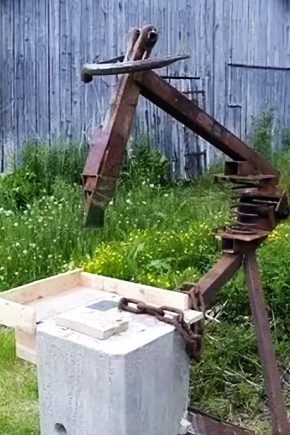
Such a source of heat as wood (firewood) has been known to mankind since ancient times, and although gas heating is almost universally now used, firewood remains relevant and in demand for a large number of the population to this day. However, the preparation of firewood for the winter as a source of heat is laborious, because it is necessary not only to deliver the wood, but also to process it. Over time, human thought has improved this process - folk craftsmen have come up with such a convenient device as a mechanical wood splitter.
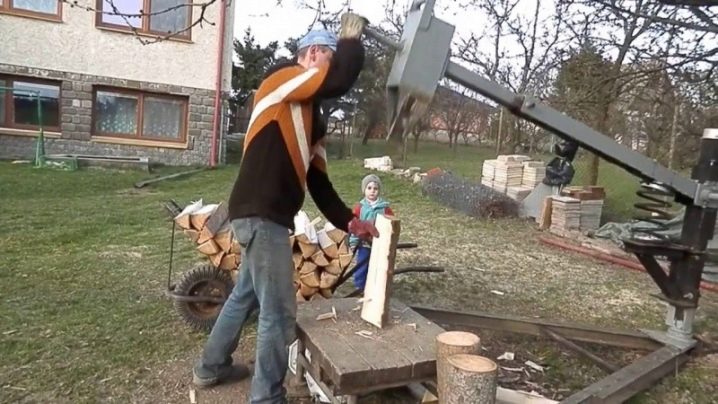
Design and principle of operation
Firewood will not lose its relevance for a long time, remaining a convenient, economical and environmentally friendly type of fuel. There are several reasons for this:
- in the outback in many houses to this day there is no alternative to stove heating;
- saunas, baths, offering their services to attract customers, almost always indicate that they use firewood to generate heat, moreover, environmentally friendly and of certain species;
- no picnic is complete without a good old fire - both for cooking and for creating a warm and cozy atmosphere.
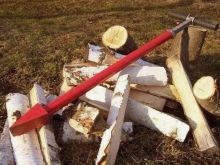
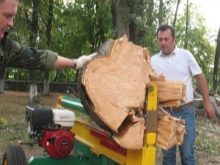
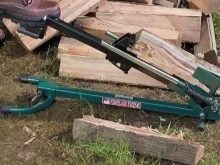
Initially, various types of manual cleavers and wedges were used to facilitate the process of splitting firewood. But during operation, such primitive devices proved to be ineffective, as they were traumatic, and often just got stuck in a log. Therefore, they were replaced by a wood splitter. This simple mechanism saves not only energy, but also a lot of time. But the craftsmen did not stop there either, deciding to completely minimize the effort and time spent on the process of harvesting firewood, improving the technology of woodcutters. This is how the mechanical type wood splitters appeared.
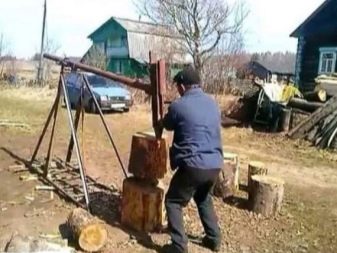

This idea was picked up by numerous industrial enterprises, but such mechanisms are not cheap, so the answer to the question - how to make a mechanical wood splitter with your own hands - remains very relevant.
Depending on the type of construction, the wood splitter consists of a simple support-shoulder to increase the applied force or a number of side mechanisms that serve to facilitate the process of harvesting firewood. Side mechanisms include the shoulder to which the cleaver is attached, and the frame - the frame on which the cleaver is held. In general, a complex of such simple devices forms a mechanism that can facilitate the work of harvesting firewood.
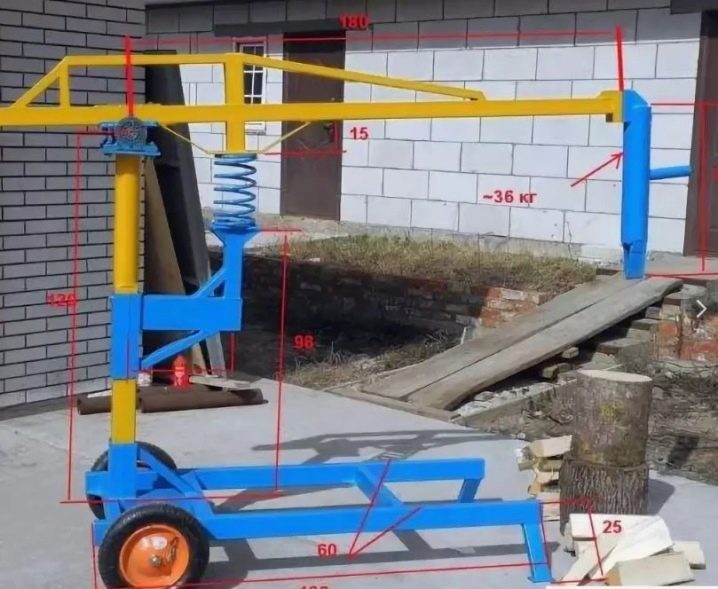
Pros and cons of homemade models
Consider several of the most successful models of mechanical wood splitter, which are easy to manufacture, convenient to use, safe and able to simplify the process of processing wood into firewood as much as possible. Mechanical wood splitters are divided into several types. Consider their pros and cons.
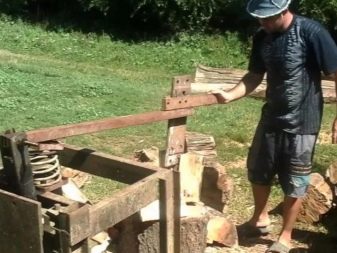

Mechanized wood splitter
An uncomplicated version of a homemade wood splitter with the simplest drive, which is the easiest to manufacture, since it does not require large cash costs. Even in the case when the necessary parts are not found, their acquisition will not be difficult. However, such a device will bring the greatest benefit only with a minimal need for firewood. The disadvantages of such a wood splitter are the long handle on which the cutter is attached, and considerable effort. But even such a primitive mechanical wood splitter can significantly facilitate the work of preparing firewood.
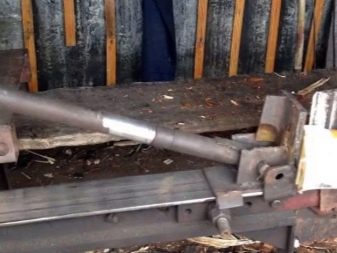
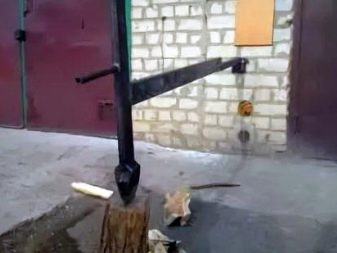
Spring loaded wood splitter
A pressure or spring log splitter implies certain costs for materials for manufacturing, but will significantly reduce the load on the muscles of the worker. The mechanics remain the same, but a spring shelf is added to the rack. The spring should not deform during compression and have a certain elasticity (Fig. 2). The height of the bed of such a wood splitter is usually 65-80 cm.The design is simple, takes up little space, but has its drawbacks:
- such a wood splitter requires complex work with a percussion tool, which increases the risk of injury;
- it greatly facilitates, but does not reduce the effort when harvesting firewood to a minimum.
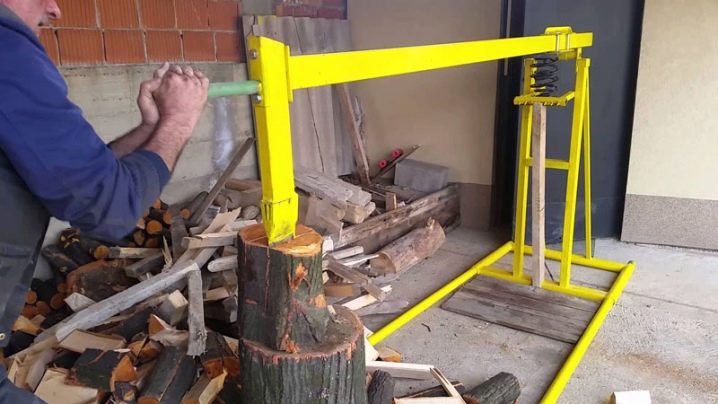
Vertical inertial log splitter
Another simple option for a mechanical wood splitter. The advantages of such a wood splitter are the simplicity of manufacture and the cheapness of the material. And also this wood splitter will pleasantly facilitate the work with soft types of wood. Such a wood splitter has few drawbacks - it is useless for working with viscous varieties of wood, since the cleaver will get stuck in the log and getting it, given the small size of the wood splitter, will be problematic.
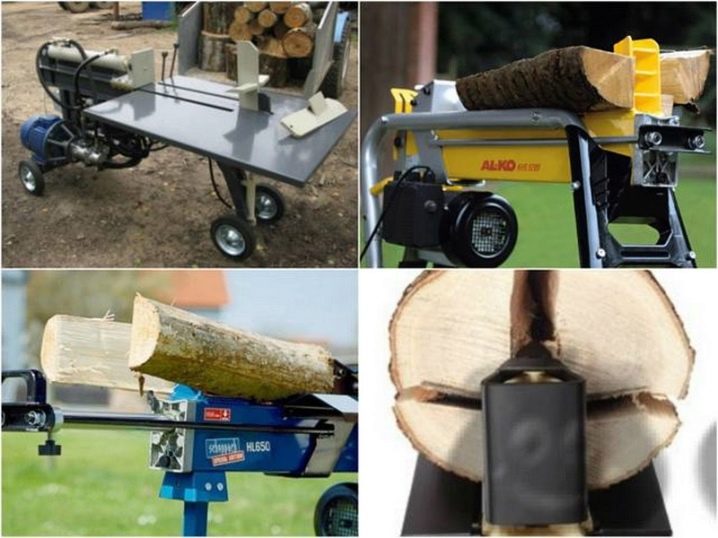
Electromechanical wood splitter
In order to make your work as easy as possible in the process of turning wood into solid fuel by using a mechanical wood splitter, it is possible to install an electric drive on it, as shown in the photo (Fig. 4). However, the manufacture of such a wood splitter requires certain costs, knowledge of electromechanics, the ability to read drawings and the use of electric welding.
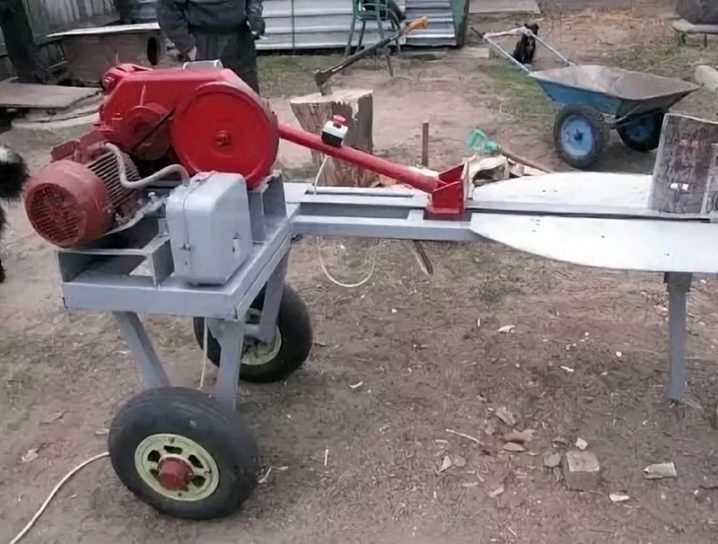
Tools and materials
To make a mechanical wood splitter with your own hands, you will need:
- pipe;
- metallic profile;
- ax or cleaver.
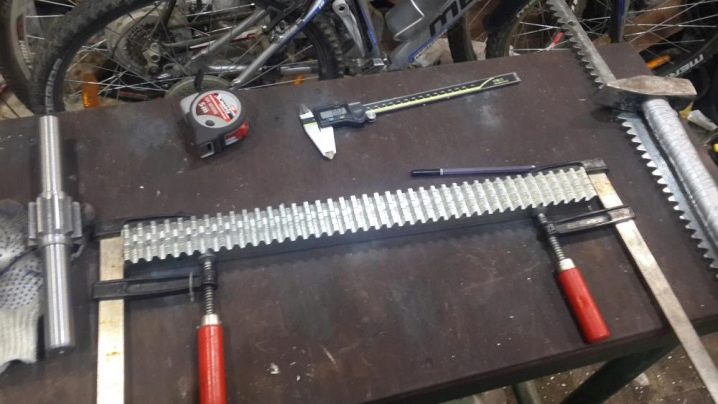
To make a vertical inertial wood splitter you will need:
- two metal pipes of different diameters;
- a weighty piece of metal in the form of a plate for the base;
- directly the executive tool - the cutter.

In order to assemble the most effective type - an electromechanical wood splitter - at home, you will need to make a cone. It is made from a ST-45 cylinder. Length - 14.5 cm, diameter - 55 mm. Tilt angle 30 degrees. Then, on a lathe, a thread with a depth of 2 mm is applied to the resulting part (step 7 mm). The manufactured part is put on the motor shaft or the gearbox axle and secured with a pin. On the other side of the shaft, a bearing is put on the axle, and a sprocket for a chain or a pulley for a belt is attached. The cone is located at a height of 10-15 cm from the surface of the frame-bed.
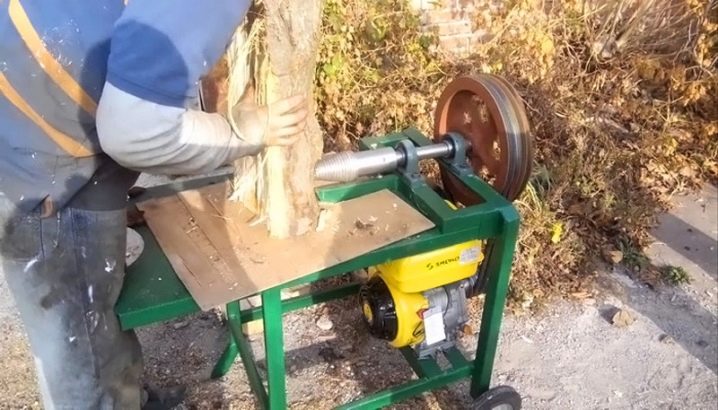
Materials for making:
- ST cylinder - 45;
- electric motor;
- metal for assembling the bed;
- belts or chain;
- starting device;
- sheet steel for the manufacture of protective covers.
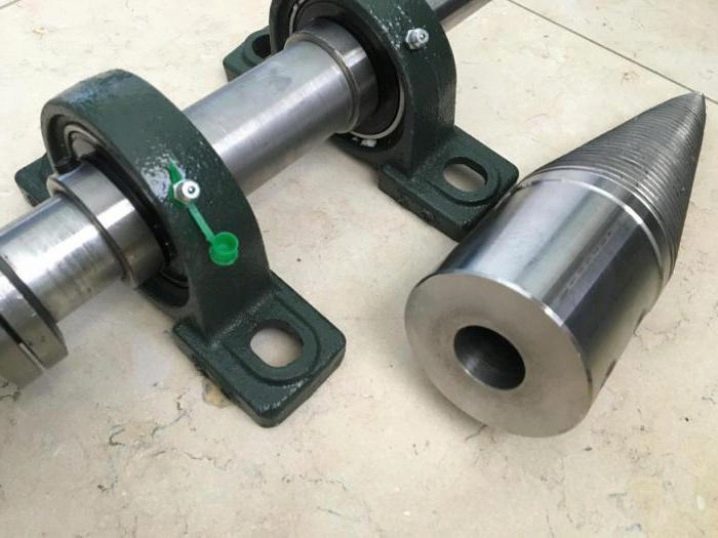
Pros - minimum effort in the procurement process. Cons - it will be expensive to assemble such a log splitter at home. It is necessary to spend not only on the purchase of the necessary materials, but also on the services of turners, electrical fitters and welders.
How to do it?
The easiest way is to make a mechanized wood splitter (Scheme 1). The assembly is very simple: the cutting part is mounted on a vertical rod with a sole made of any profiled metal, but leaving the possibility of free movement of the rod. The movement unit can consist of two welded ears with holes on the stand and a metal pin-pin, which serves as a shaft for turning the mount and the cleaver.
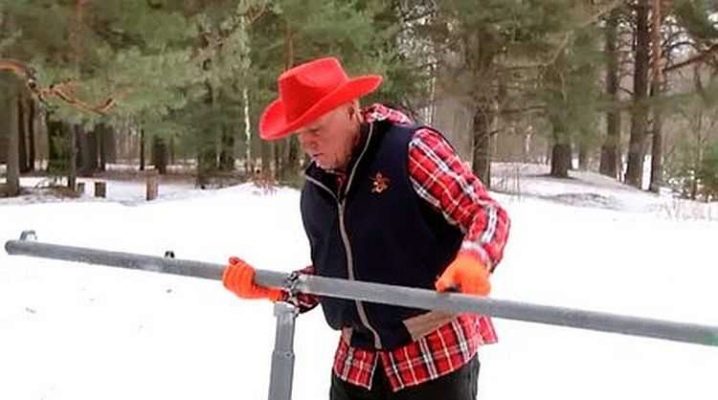
A press or spring wood splitter will require a little more effort to manufacture. A shelf is welded between the bed and the horizontal movable arm with the cutter, on which the spring is installed and fastened, the second end of the spring is attached to the horizontal arm of the wood splitter, damping the blows to the cutter (cleaver).Taking into account the fact that the executive part of the wood splitter becomes heavier, then the blow on the split deck is made with a minimum of effort (Fig. 2). However, some effort is still required, since recoil will occur due to the spring. At this point, attention should be paid to the spring used in the device so that the cleaver remains effective on impact, can calmly chop wood, and at the same time the shoulder of the structure would be easier to hold during recoil.
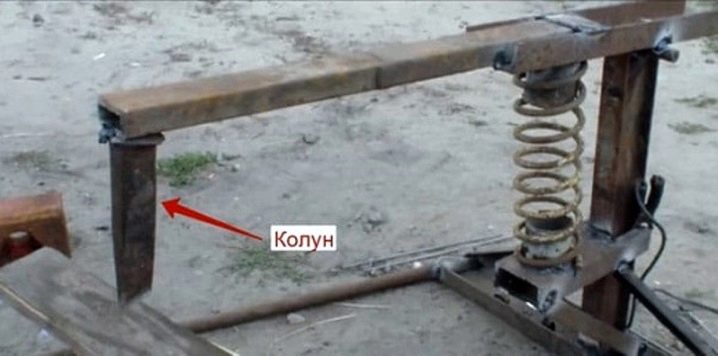
It is very easy to assemble the vertical inertial log splitter. First you need to weld the first pipe to the base plate. The length of such a pipe is slightly more than a meter (Fig. 3). Then, from a pipe of a larger diameter, it is necessary to cut a piece that will be greater than the length of the splitter. Then it is necessary to weld the cleaver to a piece of a tube of a larger diameter and put it on the base tube. The principle of operation is extremely simple - they set the log on the base under the cleaver and beat it from above with another log or sledgehammer.

An electromechanical wood splitter will require costs for the engine itself, metal for the manufacture of the frame, gearbox, cone (actuator), accessories and consumables. A drawing of the executive part (cone) is shown below (Fig. 5).
An engine is installed on the frame, it is connected to a gearbox, which transmits movement to the cone directly or through a belt drive. In order to power such an electric motor, certain skills are required, since the special parameters and requirements for the motor are taken into account. The motor power should not be less than 2 kW, and the number of revolutions, as a rule, from 250 to 500. Such a motor can be connected directly to the cone.

It doesn't matter if you can't find a suitable engine. In this case, you need to purchase a gearbox - increasing or decreasing the number of revolutions, depending on the number of engine revolutions. Consequently, a motor with a number of revolutions from 250 to 500 can be installed directly with a cone, and a motor using a gearbox is better placed at the bottom of the frame and transmitted by belts.
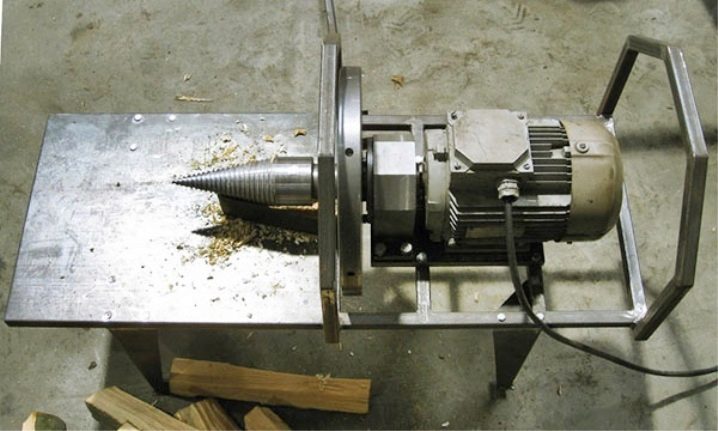
Safety instructions
There is always a risk of injury when working with mechanical devices of any type. When using homemade wood splitters, this risk is often increased rather than reduced. Always and under any conditions, do not forget about safety precautions. When using a mechanical wood splitter:
- in order to protect yourself as much as possible from all kinds of injuries, sawdust or chips in the eyes, it is necessary to work in protective clothing, shoes, glasses and a protective helmet;
- wood used for processing must be firmly installed and fixed in gutters or special recesses;
- do not work in poor visibility conditions or on slippery surfaces;
- all elements of a mechanical wood splitter must be firmly welded and fixed to each other;
- the cleaver or cutter should not have chips and cracks;
- you should not be engaged in harvesting firewood in the immediate vicinity of other people;
- it is important to closely monitor the condition of the tool used.
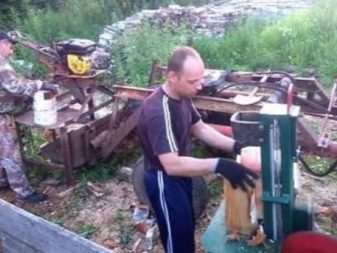
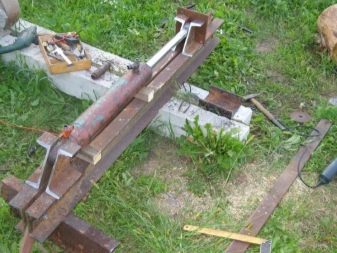
When using mechanisms with an electric drive, first of all, attention should be paid to the electrical part, as well as:
- the wiring must correspond to the required cable section and not get warm while using the tool;
- all used parts - sockets, electrical plugs, starting equipment - must not have visible damage and must be supplied to the electrical network in accordance with the standard;
- all moving elements of the mechanism must be fenced off with a protective casing and a grate to prevent work clothes, hair and other things from getting into them;
- work clothes should be tight, tucked in, complete and free from sagging;
- when using a belt, it is best to fill up the free residue;
- glasses and gloves must be complete, glasses must have a good view.
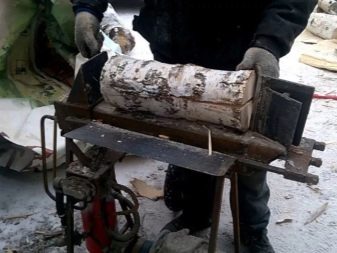

Wood splitters have become indispensable helpers when harvesting a large amount of firewood. They save a lot of time and human effort, and do not require significant expenditures for their own production, in contrast to factory samples. But do not forget that in reasonable amounts, physical labor ennobles and educates the will of a person. Therefore, sometimes it is more pleasant and useful to carry out a small part of the preparation of firewood with an ordinary ax.
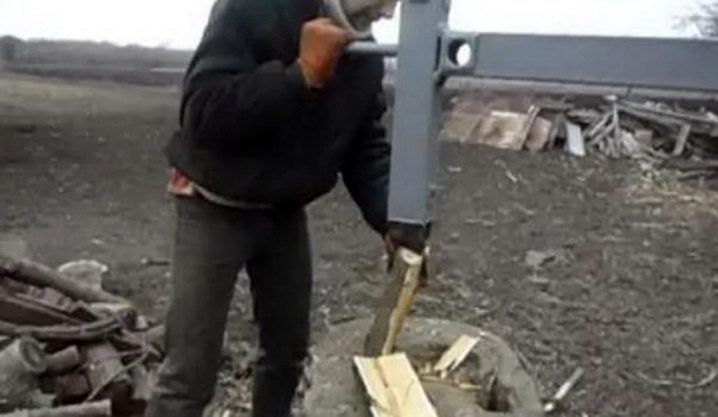
For information on how to make a wood splitter with your own hands, see the next video.



































































The comment was sent successfully.